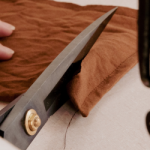Fashion designer qualifications serve as the roadmap for aspiring designers to enter this creative sphere. These fashion designer qualifications often include a relevant educational background in fashion design, such as a degree or diploma, coupled with an innate sense of creativity and a keen eye for trends and style. In this domain, a blend of formal education and practical skills is crucial.
In this blog, we’ll delve into the eligibility criteria for fashion designing, exploring the necessary fashion designer qualifications. Additionally, we’ll uncover the path to becoming a fashion designer, understanding the diverse roles, responsibilities, and the skill set required to thrive in this competitive industry.
Table of content
Eligibility for Fashion Designing Courses After 12th
How to be a Fashion Designer
Roles and Responsibilities of a Fashion Designer
Scope as a Fashion Designer in India
Salary of a Fashion Designer in 2024
Courses to Become a Fashion Designer
Eligibility for Fashion Designing Courses After 12th
Fashion designer qualifications after completing 12th grade typically include:
- Educational Qualifications: Candidates must have completed their 10+2 from a recognized board or institution. Certain colleges or universities may have specific subject requirements or minimum marks criteria in 12th-grade examinations, particularly in art or design-related subjects.
- Entrance Exams: Some institutes conduct entrance exams as part of their admission process. Clearing these exams or meeting the required scores is necessary for admission into fashion design courses.
- Portfolio: Aspiring fashion designers often need to showcase their creativity through a portfolio that highlights their artistic skills, designs, sketches, or any related projects.
- Language Proficiency: Proficiency in English is usually preferred, especially for courses that have international exposure or collaborations.
- Interviews or Aptitude Tests: In addition to written exams, some institutes might conduct interviews or aptitude tests to assess a candidate’s interest, creativity, and understanding of fashion.
It’s important to note that eligibility criteria may vary among institutions and different courses within fashion designing. Candidates should thoroughly check the specific requirements of the institutes or universities they wish to apply to for accurate and detailed information.
How to be a Fashion Designer?
Becoming a fashion designer typically involves a combination of education, training, creativity, and industry experience. Here are steps you can consider to pursue a career in fashion design:
- Education and Training: Pursue formal education in fashion design from reputable institutions offering courses or degrees in this field. It could include a degree in fashion design or a related discipline. Online courses or specialized programs can also provide valuable skills.
- Develop Skills and Creativity: Cultivate your artistic skills, including sketching, drawing, and using design software. Experiment with different fabrics, patterns, and styles. Developing a unique creative voice is essential in the competitive fashion industry.
- Gain Experience: Seek internships, apprenticeships, or entry-level positions in fashion houses, design studios, or with established designers. Real-world experience provides invaluable insights into the industry, practical skills, and networking opportunities.
- Build a Portfolio: Create a portfolio showcasing your best designs, sketches, and projects. A strong portfolio is crucial when applying for jobs or presenting your work to potential clients or fashion schools.
- Stay Updated: Keep abreast of current fashion trends, industry news, and technological advancements. Attend fashion shows, workshops, and exhibitions to network and gain insights into the evolving fashion landscape.
- Networking: Build relationships within the fashion industry. Networking with fellow designers, industry professionals, and mentors can open doors to opportunities and collaborations.
- Persistence and Dedication: Success in fashion design often requires perseverance, resilience, and a willingness to learn from setbacks. Stay dedicated to your craft and continually refine your skills and style.
Remember, the path to becoming a fashion designer may vary for individuals, but a combination of education, skill development, practical experience, and determination can pave the way for a rewarding career in fashion design.
Roles and Responsibilities of a Fashion Designer
Fashion designers play a pivotal role in the fashion industry, contributing their creative vision, technical expertise, and managerial skills. Some key roles and responsibilities include:
- Conceptualizing Designs: Fashion designers conceive and develop innovative clothing and accessory designs, often starting with sketches or digital renderings. They envision styles, patterns, and color combinations while considering market trends and consumer preferences.
- Fabric Selection and Material Sourcing: They research and select appropriate fabrics, trims, and materials for their designs. Understanding textile properties, quality, and availability is crucial in creating the desired aesthetic and functionality.
- Pattern Making and Prototyping: Translating designs into tangible garments involves creating patterns and prototypes. Fashion designers work with patternmakers and sample makers to construct and refine these prototypes.
- Overseeing Production: They collaborate with manufacturers or production teams to ensure designs are executed as intended. This involves managing the production process, quality control, and adhering to timelines and budgets.
- Staying Updated on Trends: Fashion designers stay abreast of current fashion trends, market demands, and cultural influences. This awareness helps them create collections that resonate with consumers.
- Collaborations and Presentations: They often collaborate with marketing, sales, and merchandising teams to promote and present their designs. Fashion designers may showcase their collections through fashion shows, presentations, or marketing campaigns.
- Adaptability and Problem-Solving: Adaptability is crucial as the fashion industry is fast-paced and subject to constant change. Fashion designers need strong problem-solving skills to address challenges in design, production, or market reception.
- Business Acumen: Many fashion designers manage their brands or work within fashion houses. Understanding business aspects like budgeting, branding, and market positioning is essential for success.
Fashion designers need a blend of creative flair, technical skills, industry knowledge, and business acumen to excel in this competitive field. Each role may vary based on the segment of the industry they work in, whether it’s haute couture, ready-to-wear, or niche design specialties.
Scope as a Fashion Designer in India
The scope for fashion designers in India is broadening, offering diverse opportunities across various segments of the industry:
- Apparel Industry: Fashion designers play a pivotal role in creating clothing lines for brands, both domestic and international. The burgeoning demand for innovative designs and sustainable fashion has opened avenues for designers to collaborate with renowned brands or start their labels.
- Textile and Garment Manufacturing: With India being a hub for textile production, designers can contribute to enhancing the quality, design, and innovation in textile and garment manufacturing units.
- Retail and E-commerce: The retail sector is evolving rapidly with the advent of e-commerce. Fashion designers have opportunities to work with online platforms or retail chains to curate exclusive collections, enhancing consumer experiences.
- Media and Entertainment: Fashion designers are increasingly sought after in the entertainment industry, contributing to costume designing for movies, TV shows, and events. This platform offers exposure and visibility for their work.
- Entrepreneurship: Many aspiring designers venture into entrepreneurship by establishing their fashion labels or boutiques, catering to niche markets or addressing specific fashion needs.
- Consultancy and Education: Experienced designers often transition into consultancy roles or academia, sharing their expertise in design schools or working as design consultants for various brands.
The expanding consumer base, growing fashion consciousness, and the emphasis on unique designs and sustainable practices make the fashion industry in India promising for aspiring fashion designers.
Salary of a Fashion Designer in 2024
The salary of a fashion designer in India can vary significantly based on factors such as experience, skill set, location, employer, and the segment of the industry they work in. Here’s an approximate salary range across various experience levels:
- Entry-level or Trainee Fashion Designers: Starting salaries for trainees or entry-level designers could range from ₹20,000 to ₹35,000 per month.
- Mid-Level Fashion Designers: With a few years of experience, designers can earn between ₹40,000 to ₹80,000 per month, depending on their skills and the organization they work for.
- Senior or Experienced Fashion Designers: Experienced designers, especially those leading design teams or working with established brands, can earn significantly higher salaries ranging from ₹1 lakh to ₹3 lakhs or more per month.
Additionally, fashion designers who establish successful labels or venture into entrepreneurship have the potential for higher earnings, but these incomes can be variable and contingent on the success of their brands.
Courses to Become a Fashion Designer
Here are some courses that aspiring fashion designers can consider:
- Diploma in Fashion Design: AAFT Online offers a comprehensive diploma in fashion design that covers various aspects of the field, from design principles to garment construction and industry-specific software training.
- Bachelor’s Degree in Fashion Design: Several universities across India offer bachelor’s programs in fashion design, providing a more in-depth and extensive study of the subject.
- Master’s Degree in Fashion Design: For those seeking advanced knowledge and specialization, pursuing a master’s degree in fashion design can be beneficial.
- Online Certification Courses: There are also online platforms offering certification courses in specific aspects of fashion design, such as pattern-making, textiles, or fashion illustration. These courses can enhance specific skills.
- Short-term Workshops and Training Programs: Various workshops and training programs, both online and offline, provide short-term, skill-focused training in areas like draping techniques, fashion sketching, and trend analysis.
While a formal education is valuable, building a strong portfolio and gaining practical experience through internships or apprenticeships are equally important in the fashion industry.
Conclusion
In the dynamic world of fashion design, qualifications serve as the launchpad, but creativity, dedication, and practical experience fuel the journey to success. Pursuing courses like the AAFT Online Diploma in Fashion Design or formal degrees, coupled with hands-on learning, builds a sturdy foundation. Fashion designer qualifications set the stage, but it’s the amalgamation of passion and expertise that defines a truly remarkable career in this thriving industry.















